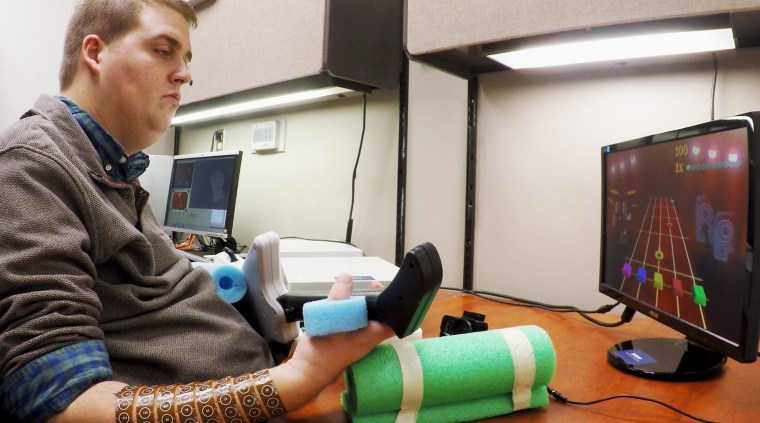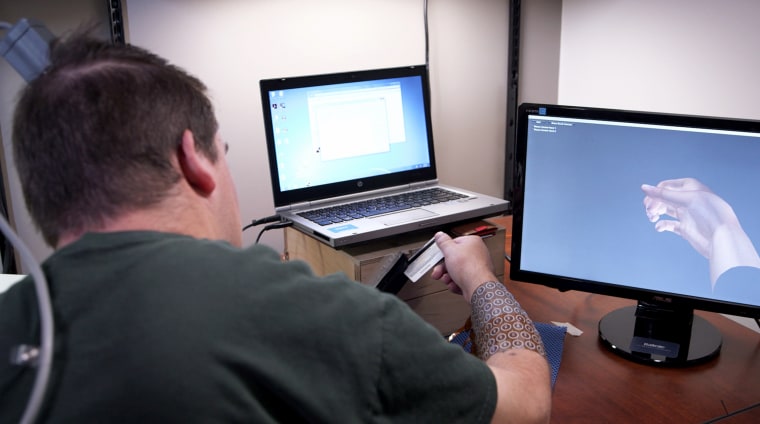Ian Burkhart is paralyzed from the chest down. But he can pick up a credit card and swipe it. He can pick up a bottle and pour. And he can do it all just by thinking about it.
It’s the latest advance in efforts to help restore movement to people who are paralyzed. In Burkhart’s case, a small brain implant picks up his thoughts and transmits them to a computer, which then sends signals to a sleeve that twitches his hand into action.

“I just think about what I want to do and now I can do it,” said Burkhart, 24.
It’s not seamless. Burkhart is plugged in – a large plug at the top of his skull, and wires attached to the sleeve that stimulates his arm, wrist and finger muscles.
But Dr. Ali Rezai ofOhio State University, who worked on the project, says wireless technology will eventually remove those barriers.
“I just think about what I want to do and now I can do it."
“Your cellphone…will be communicating with your sleeve,” he said. “Patients like Ian can be in charge of their own lives and be independent.”
Many different groups are working on ways to help people move using just their own thoughts. There are three big parts: figuring out which brain signals correlate to their intentions to move, translating those signals into something a computer can read, and then moving the muscles.
People have learned to control robotic arms with brain implants and a lot of training, including Jan Scheuermann, who's been testing a device at the University of Pittsburgh and who first used her robotic arm to eat chocolate.
People have controlled robotic exosketons using electrodes and, earlier this year, researchers showed they had trained two monkeys with brain implants to steer wheelchairs using only their minds,
Amputees have learned to move prosthetic arms with shoulder shrugs, and a team helped four paralyzed men move their legs by stimulating their spinal cords.
Burkhart’s been working with doctors and engineers for years. He was paralyzed in a diving accident as a teenager and can’t move much more than his head and shoulders without help.
He had what’s called a neural array implanted into his brain. Its signal isn’t strong enough alone, so he’s still plugged in when he uses it. “This is kind of our window into Ian’s neural activity,” said Chad Bouton of the Feinstein Institute for Medical Research in Manhasset, New York.
The hardest part may have been training the computer to recognize his brain signals. “The software is adapting and learning as well,” Bouton said.
The researchers hooked Burkhart up to a functional magnetic resonance imaging (fMRI) scanner to track his brain activity in real time.
“It creates what we call a neural bypass from the brain.”
“If I think about opening my hand over and over again, they can see what’s lighting up and then they know that’s me thinking about opening my hand,” Burkhart said.
Burkhart’s brain and the computer have learned to work together, sending signals to a sleeve that stimulates the muscles in his arm and hand.
“It takes data directly from the brain, in this case Ian’s brain, by an array that’s implanted in his brain and it decodes that and takes those signals and uses them to stimulate Ian’s own forearm to cause his muscles to contract and move in the way that he wants them to,” said Nick Annetta of the Battelle Memorial Institute in Columbus, Ohio.
“It creates what we call a neural bypass from the brain.”
It was a shock at first, Burkhart said. “Because something I hadn’t moved in about 3 ½ years ... now it’s something where I expect it to move,” he said.
“We learned that a completely paralyzed person can regain functional movement using a completely artificial neural bypass to reroute signals from the brain to the affected muscles,” Bouton said.
“Patients like Ian can be in charge of their own lives and be independent,” Rezai added.

